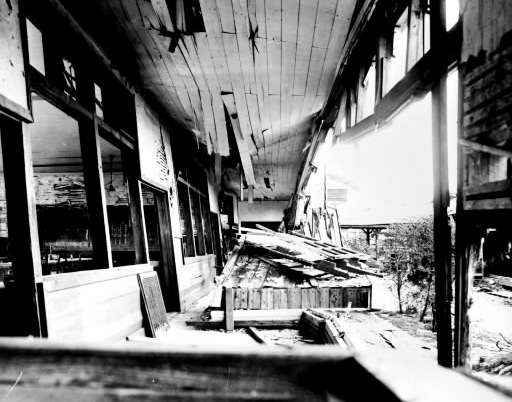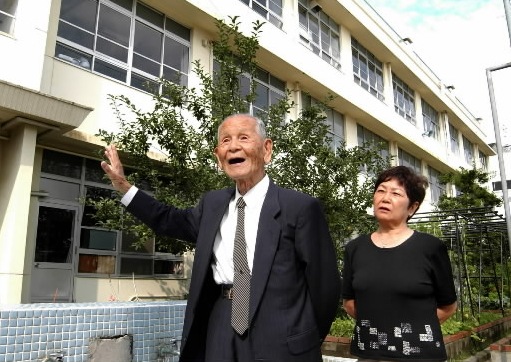Images of the Atomic Bombing, 1945~2003, Part 4
Jun. 26, 2010
Flash in the schoolyard
by Masami Nishimoto, Senior Staff Writer
In the summer of 2003, the Hiroshima Peace and Culture Foundation obtained 226 photographs from the U.S. National Archives which show the devastation caused by the atomic bombing. The photos the American forces took in their investigation of the effects of the bombing are witnesses that convey the tragedy of that time. This series [originally published in July and August 2003] traces the reality of the atomic bombing through some of these images.
Bomb explodes during morning assembly
When the atomic bomb exploded, Funairi National School (now, Funairi Elementary School) was standing 2.2 kilometers from the hypocenter. In the corridor of the north building, the window frames were blown out and the pillars were thrust inward. In the photograph, toward the left, writing made in chalk can be seen on a blackboard at the back of the classroom. First- and second-graders had gathered in the schoolyard next to the south building for morning assembly. The vice principal at the time, and one of the children, visited the school together for the first time in 58 years to share their memories.
When the two stepped onto the schoolyard, they found current students of the elementary school in Naka Ward enjoying their summer vacation by happily kicking around a soccer ball.
Hiroshi Sasamura, 94, who lives not far from the school, stepped ahead briskly. Pointing to a spot in the schoolyard, he said, "The platform for the morning assembly was placed around there." Chieko Nakagawa, 64, who lives in the same neighborhood, followed after and said, "Mr. Sasamura, the willow tree stood around there, didn't it?" The two were in this schoolyard when the blast occurred.
In April 1945, the city of Hiroshima began group evacuations of elementary school children. They were brought into the countryside, in case the city became a target of air raids. But smaller children, mainly those in the first and second grades, remained at home with their families. At Funairi National School, the number of children that stayed behind was recorded as 318. Of this total, Mr. Sasamura remembers that, on August 6, about 120 children were at school.
Mr. Sasamura was set to speak to the children, in place of the principal who was away from school that morning. "The children were all very thin because food was so scarce. As the sun was strong, I had the children stand in two lines under the big willow tree, one for boys and one for girls."
One boy was looking up at the sky and Mr. Sasamura was about to call the boy's name when the bomb flashed. "Get down!" he yelled. But as he told the children to lie flat on the ground, he became trapped under the broken roof of the wooden school building that had been standing behind him.
"When I came to," Mr. Sasamura recalled, "I heard the children out in the sweet potato field, crying for their mothers."
"That's where I fled," said Ms. Nakagawa, then a first grader, gazing in that direction. To the south of the schoolyard was a large field where sweet potatoes were grown for school lunches.
Luckily, the shelter of the big willow tree saved most of the children, although two girls in the second grade were killed. "At the time, I thought our school was the target," said Mr. Sasamura. He hurried to the civil defense post for help, but found no one there. He began to see fires rising here and there while moving about.
People smeared with soot soon streamed into the grounds of the school and sat down in a stupor. Mr. Sasamura spent a sleepless night on straw mats spread out in the schoolyard with seven or eight children whose parents had not appeared to pick them up. His own wife and children had already been evacuated out of the city before the bombing.
Ms. Nakagawa went home with her older sister and other children. Her house was in ruins. "But a closet was still standing," she recalled, "so that's where we slept."
Standing in for the principal, Mr. Sasamura devoted himself to writing out "victim certificates." "Without one, you couldn't get rations," he explained. According to the "Record of the Atomic Bomb Disaster," compiled by the city, thousands of survivors from the Funairi, Eba, and Kanon districts waited in long lines to obtain these certificates.
At the school grounds, the south building, which still barely stood, finally collapsed on September 17 in a powerful typhoon. The following February, a one-story school building was constructed at the former site of the north building using wood donated by the local neighborhood association, and full-scale teaching resumed. But there still weren't enough classrooms so lessons were also held outdoors on the school grounds. Mr. Sasamura and Ms. Nakagawa spoke about the situation as if it had been experienced just yesterday. Of the city's 39 public schools, only 11 were still functional at that time.
Ms. Nakagawa shares the history of Funairi Elementary School with its current students. Her children and grandchildren attended the school, too. "We used our pencils down to the nub. When I talk about such experiences with the students, they listen closely to me."
At the age of 77, Mr. Sasamura began speaking about his experience of the bombing to students visiting Hiroshima on school trips. "But when I turned 90, I stopped. I'm too old now," he said with a laugh.
Each year on August 6, he visits his old school, carrying a radio to hear the Peace Memorial Ceremony from Peace Memorial Park. At the sound of the Peace Bell tolling through his radio, he offers a silent prayer by himself. He feels compelled to stand here in this schoolyard to pray.
(Originally published on August 2, 2003)









